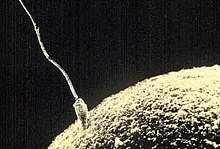Sperm

Sperm are the male reproductive cells. Most animals and plants use sperm to reproduce. They have different ways of making and releasing the sperm. In all cases the sperm meets with the egg of the female and together they grow into a new organism.
The name sperm is taken from the Greek word sperma meaning seed.[1]
An animal sperm cell is capable of movement, as it has to get to the uterus to meet with the ovum. Animal sperm cells (including humans) have small 'head' and a long tail called a flagellum. The flagellum acts like a motor to propel the sperm cell through the female reproductive system.
In humans[change | change source]
Human sperm is made in the testicles of a man. Human sperm contains 23 chromosomes. A human needs 46 chromosomes, so a sperm cell is called a haploid as it only has half. The other half is contained within the ovum or egg of a female. During sex, semen is shot out of the man's penis during ejaculation. Semen carries the sperm into the woman's vagina and down to the ovum in the uterus. During ejaculation millions of sperm cells are released in the semen, but only one hundred or so reach the egg.[2] The egg can merge with one sperm cell that reaches it. Because it now has 46 chromosomes, it is called a diploid, like ordinary cells of the body. This diploid is called a zygote, and it can grow into a fetus and eventually a baby.
In plants[change | change source]

Some plants such as ferns and mosses have sperm that move. Flowering plant sperm cells cannot move by themselves. The flowering plant sperm cells are contained within pollen grains. Thus, they rely on transportation to take their sperm cells to other plants. For example, a bee lands on a plant to collect the nectar. Some pollen will get stuck to the bee. The bee moves on to another plant and the pollen falls onto that plant. The sperm is moved down a pollen tube until it reaches the ovule at the bottom of the flower.
References[change | change source]
- ↑ "Etymology of Sperm".
- ↑ "SemenAnalysis Male Fertility Test, Sperm Count". Archived from the original on 2008-08-28. Retrieved 2008-08-30.

